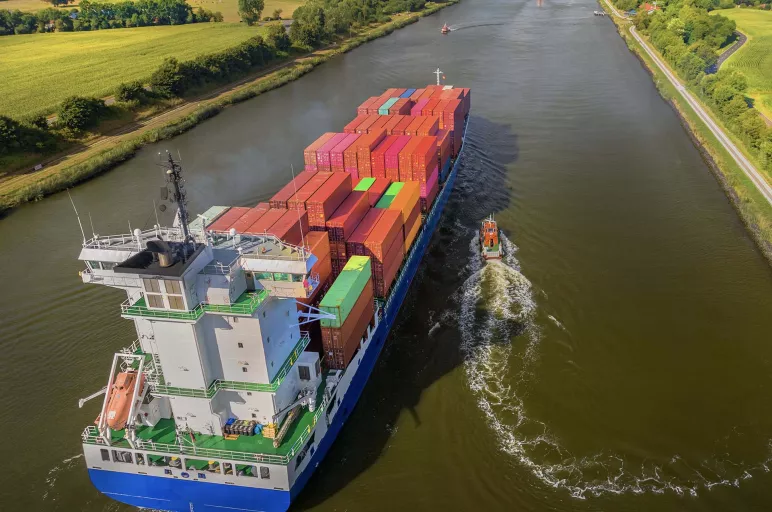
A Deep Dive Into Upstream and Downstream Supply Chain
- Upstream supply chain operations encompass supplier management, procurement and transportation and ensure a reliable supply of input materials.
- Downstream supply chain involves order management, warehousing and transportation and timely product delivery and customer satisfaction.
- Visibility, intelligence and collaboration are essential for optimizing both upstream and downstream supply chain operations
July 02, 2025 | Supply Chain Strategy 4 minutes read
The supply chain is the backbone of any business, responsible for the smooth flow of goods and services from the initial production to the delivery to the final consumer. It encompasses a series of interconnected activities, including procurement, production, distribution and customer service.
Having an understanding of the intricacies of supply chain processes is crucial for businesses to optimize their operations, and it’s helpful to start by understanding some fundamental supply chain terms – upstream and downstream.
What is Upstream Supply Chain?
Upstream operations refer to the initial stages of the supply chain, where raw materials are sourced, acquired and transported to manufacturing facilities. This stage involves activities such as supplier selection, procurement and inventory management. Efficient upstream operations play a vital role in ensuring a continuous and reliable supply of raw materials, which is essential for efficient, uninterrupted production.
The key components of upstream operations include supplier management, procurement and transportation.
- Supplier management involves establishing strong relationships with reliable suppliers who can provide high-quality materials at competitive prices.
- Procurement focuses on the process of acquiring the required raw materials, ensuring that the materials meet the specified quality standards.
- Transportation is another critical component, as it involves the movement of raw materials from suppliers to manufacturing facilities, making timely deliveries a top priority.
Challenges in Upstream Operations
Supply chain disruptions, such as natural disasters, political unrest or supplier issues, can hinder the smooth flow of materials. These disruptions can lead to delays in the delivery of raw materials, causing production delays and increased costs.
Another challenge is the need for effective inventory management to avoid overstocking or understocking of raw materials, which can impact production efficiency and customer satisfaction.
Strategies for Optimizing Upstream Operations
To optimize upstream operations, businesses can diversify their supplier base to reduce dependency on a single supplier. This ensures a continuous supply of raw materials even in the event of supplier issues. Implementing advanced technology, such as AI-powered supply chain management software, can also streamline procurement processes and enhance visibility.
Additionally, businesses can establish robust communication channels with suppliers to ensure transparency and improve collaboration.
Understanding Downstream Supply Chain
Downstream operations encompass the final stages of the supply chain, where finished products are distributed to customers. This stage involves activities such as warehousing, transportation and order fulfillment. Efficient downstream operations are crucial for maintaining timely product delivery, customer satisfaction and a competitive edge in the market.
Key aspects of downstream operations include order management, warehousing and transportation.
- Order management involves efficiently processing customer orders, tracking inventory levels and coordinating order fulfillment.
- Warehousing plays a vital role in storing and managing inventory, ensuring products are readily available for distribution.
- Transportation ensures the timely delivery of products to customers, requiring efficient logistics and distribution networks.
Challenges in Downstream Operations
Downstream supply chain operations face their own set of challenges. One significant challenge is the increasing customer expectations for faster delivery times and flexible order fulfillment options. Meeting these expectations requires businesses to optimize their logistics networks and adopt innovative delivery strategies.
Another challenge is reverse logistics, which involves handling product returns and managing the associated costs and customer service issues.
Strategies for Optimizing Downstream Operations
To optimize downstream operations, businesses can invest in advanced order management systems that automate order processing, inventory tracking and order fulfillment. This streamlines operations, reduces errors and improves customer satisfaction.
Furthermore, businesses can leverage technology to enhance transportation and logistics capabilities, such as real-time tracking and route optimization. Collaboration with third-party logistics providers can also help businesses tap into their expertise and resources to improve overall efficiency.
The Importance of Visibility, Intelligence and Collaboration in the Supply Chain
Visibility, intelligence and collaboration are key capabilities in optimizing supply chain operations, whether upstream or downstream.
Having end-to-end visibility allows supply chain professionals to identify bottlenecks, inefficiencies and potential disruptions.
Real-time intelligence through data analytics and AI empowers decision-makers with actionable insights, making it possible to forecast demand accurately, manage inventory efficiently and reduce costs. However, without collaboration, these insights and visibility remain isolated.
Collaboration fosters communication and cooperation among stakeholders, fostering a flexible and resilient supply chain ecosystem. Harnessing these three pillars holistically across upstream and downstream supply chain operations enables companies to enhance transparency, reduce risks and ultimately drive efficiency and profitability.
By understanding and optimizing both upstream and downstream operations, businesses can ensure a smooth flow of materials and products throughout the supply chain.
Collaboration, technology adoption and innovation are key drivers for achieving supply chain excellence.
By embracing these strategies, businesses can unlock the full potential of their supply chains and gain a competitive edge in the market.



